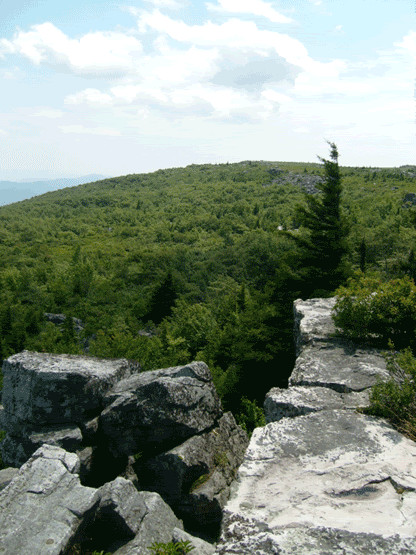
This is one of my favourite places on earth. My father is an avid gardener and backyard naturalist, and his beard is six times the size of mine. As a child we would frequent the area of Dolly Sods, a high plateau of very unusual geological features and what makes it even more unusual is its Canadian taiga plant life.

At one point this was the eastern most shore of the continent of North America, as is evidenced by the conglomerate rock (its kind of like concrete made of sandstone with large quartzite pebbles) and pure white quartz sand. The headwaters of Red Creek and its beloved hiking trail begin from the cranberry bogs where you can walk on top through marked trails on the spongy earth, and then descending through the Blue Spruce forest and a torrent of waterfalls. To make it even better, surrounding the bogs and the spruce trees is square mile after mile of wild blue berry bushes and they are free for the picking (I argue that West Virginia wild blue berries rival those of Maine and New Hampshire).
So, the day before I was to return northeast after my grandfather's funeral in Johnson City, TN my father suggested that we go to Dolly Sods. I don't know that I had ever been so excited to go, it had been about twelve years since I had been up there, and growing up this was my playground.
The sandstone is carved by wind and rain and the relentless volleys of winter, and looms like castle turrets from the undergrowth of blueberries. While most children were building forts in the woods in their back yards, I had these ready-made forts that could withstand the assault of pine cones, rocks and mud.

I showed pictures once to a friend of mine who lives in Volgograd, Russia. She referred to it as a dismal dreary place. It is true; the plateau does have its own peculiar sullen charm. Clouds can roll in a moments notice, a light drizzle, and a frigid wind. The air is even thinner, sound doesn't travel the same. Its beautiful and spooky at the same time.
This day however that my father and I went to pick blue berries was far from dreary but yet brutal from the sun. I spent a good three hours picking blue berries (I got half a gallon to bring back home) before I realized my sun burn was going to be bad. Really bad. So, while wandering, I found a neat little hollow and saw something brittle and white. I found bleaching deer bones, skull, ribs and vertebrae, likely the victim of the weather and then scavenged by coyotes. Then I made my way to the precipice of Bear Rocks, attempting to find a little shelter from the sun in the many crevices and boulder caves that I used to crawl and climb through as a kid.

The Dolly Sods Wilderness area is free of charge, and is located on Rt. 55 near Elkins, West Virginia in the Monongahela National Forest. It offers spectacular scenery, hiking, wilderness backpacking, groomed camping areas for those who don't wish to "rough it", and just abundant West Virginia wilderness that is simply unrivaled. More specific directions can be found on the Wilderness area's website http://www.fs.fed.us/r9/mnf/sp/dolly_sods_wilderness.htm. I strongly suggest sturdy shoes, and dress appropriately for the season. Even in summer the temperature difference between the bottom at nearby Smoke Hole Caverns (another cool spot to visit) and the top of the escarpment can be significant. Other nearby areas of interest are Spruce Knob, Germany Valley (excellent caving), the world class climbers' spot Senneca Rocks, and much much more.




